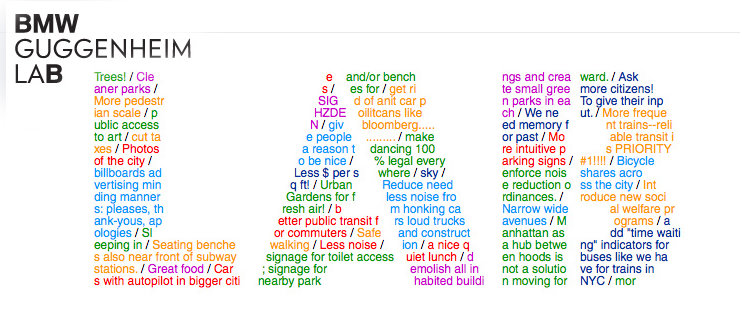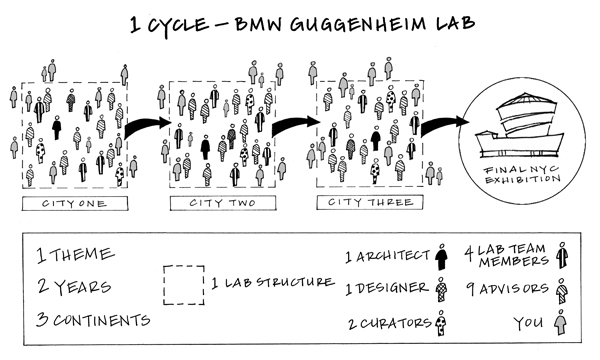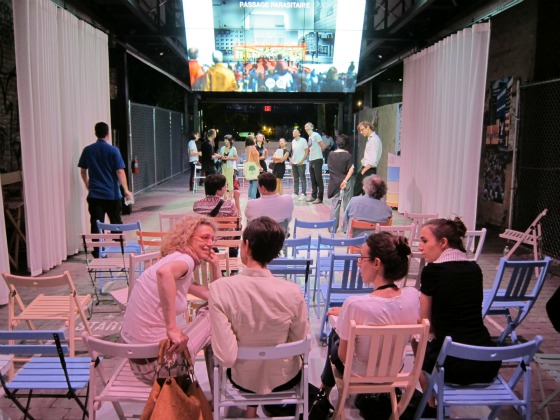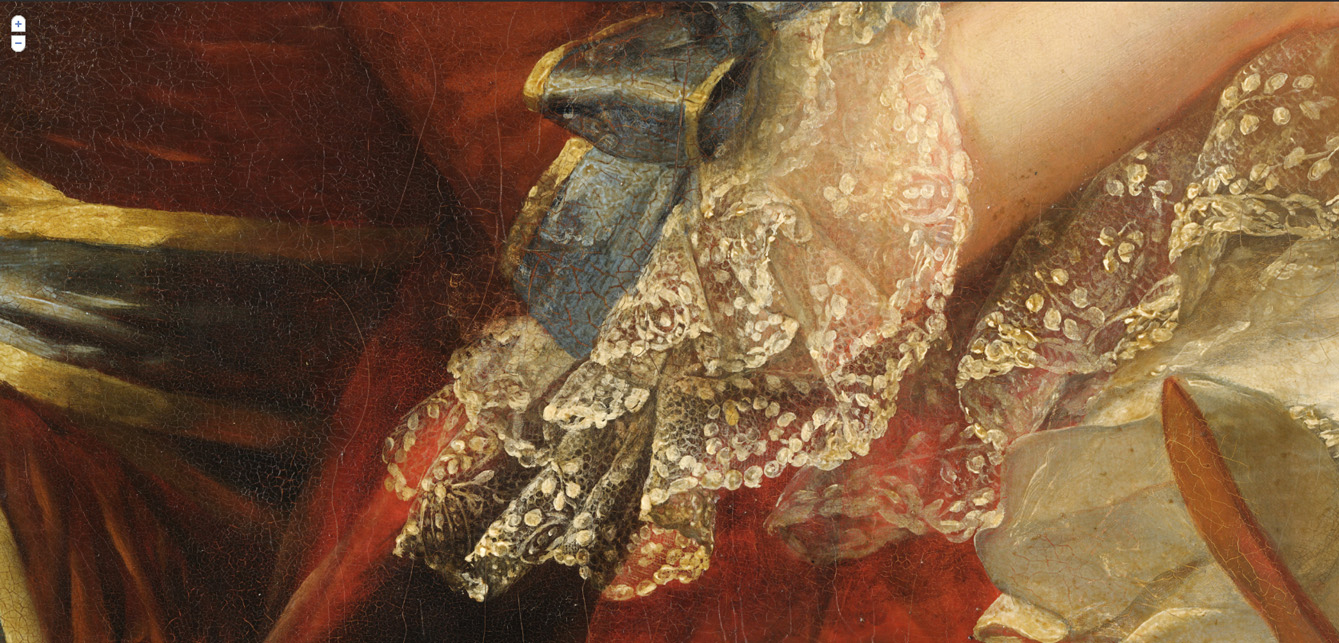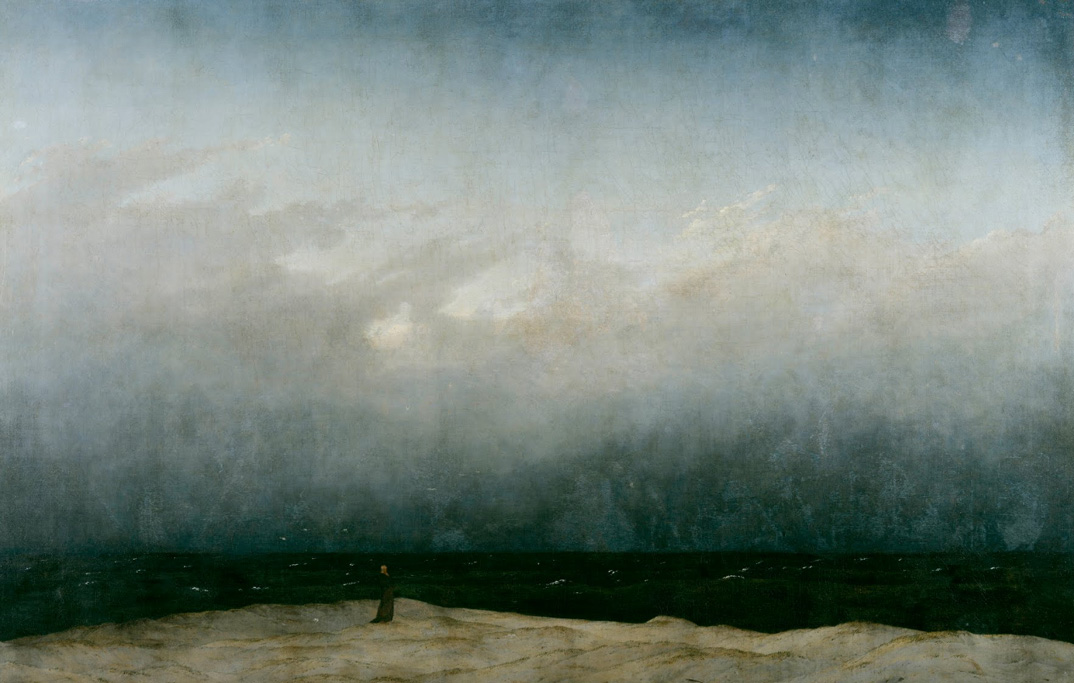President Obama declared October 2011 National Arts and Humanities Month. With celebration events happening all month, how are you choosing to celebrate?
The Warhol: Art – An App for Droid, iPhone, and iPad
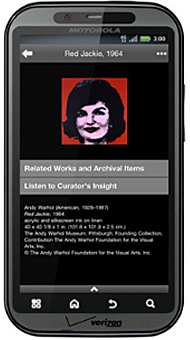 I don’t want to shock anyone, but since my last post, another art museum has released another app. The Warhol: Art is a production of the Andy Warhol Museum and Toura, and perhaps the sarcasm was unwarranted. It shouldn’t come as a surprise to anyone that a museum dedicated to such an influential part of pop culture stays on top of the latest pop culture mediums. Andy is a Carnegie Mellon University alum, so I plopped down my three bucks on the Droid Market for this application (available on the Droid, iPhone, or iPad) and proceeded to check it out.
This is the Andy Warhol Museum’s third app, and The Warhol: Art is focused on informing the users about the life and art of Andy Warhol, as well as helpful information about the museum itself. The app is useful for those who would like obscure information about Andy’s life (such as his Carpatho-Rusyn heritage) at a moments notice, and great for art history buffs.
The Warhol: Art is described as a “behind-the-scenes glimpse” at some of the Warhol’s works of art, especially pieces which are lesser known. Users can explore the life and times of Andy Warhol through sections divided by years in his life. Each section comes with a selection of related art works that he created during the time period. There's a neat "Favorites" function that allows users to star the pieces they like best from these sections. The starred items list can be accessed easily from the first screen of the app, allowing users to check out their favorite pieces quickly. A few select pieces have curator commentary buttons, which I really enjoyed. The Warhol: Art commentary buttons, however, do not actually appear on the pieces that they describe. For example, while viewing Mao, 1972, I clicked on “Curator’s Insight”, only to hear a curator discussing Warhol’s Hammer and Sickle series.
I don’t want to shock anyone, but since my last post, another art museum has released another app. The Warhol: Art is a production of the Andy Warhol Museum and Toura, and perhaps the sarcasm was unwarranted. It shouldn’t come as a surprise to anyone that a museum dedicated to such an influential part of pop culture stays on top of the latest pop culture mediums. Andy is a Carnegie Mellon University alum, so I plopped down my three bucks on the Droid Market for this application (available on the Droid, iPhone, or iPad) and proceeded to check it out.
This is the Andy Warhol Museum’s third app, and The Warhol: Art is focused on informing the users about the life and art of Andy Warhol, as well as helpful information about the museum itself. The app is useful for those who would like obscure information about Andy’s life (such as his Carpatho-Rusyn heritage) at a moments notice, and great for art history buffs.
The Warhol: Art is described as a “behind-the-scenes glimpse” at some of the Warhol’s works of art, especially pieces which are lesser known. Users can explore the life and times of Andy Warhol through sections divided by years in his life. Each section comes with a selection of related art works that he created during the time period. There's a neat "Favorites" function that allows users to star the pieces they like best from these sections. The starred items list can be accessed easily from the first screen of the app, allowing users to check out their favorite pieces quickly. A few select pieces have curator commentary buttons, which I really enjoyed. The Warhol: Art commentary buttons, however, do not actually appear on the pieces that they describe. For example, while viewing Mao, 1972, I clicked on “Curator’s Insight”, only to hear a curator discussing Warhol’s Hammer and Sickle series.
Yes, I see and understand how those pieces are related. Yes, I enjoyed the commentary on the piece because I am a huge art nerd. Practically speaking, however, were I a museum patron standing in front of Mao, 1972, hoping to hear more about it, I would be disappointed and perhaps upset to receive commentary on a completely different piece.
I believe mobile applications are quickly becoming a new way to encourage museum patrons to interact with the art, and I applaud the Warhol for encouraging this effort. The Warhol: Art is an informative app chock full of information and great art, including many lesser known and not on display pieces. However, I found some features tedious (see above), while others just did not work (none of the videos would play for me, and I could not zoom in on any of the works – this is could be due to user error).
Overall, this app is great for those who’d like to learn more about Andy Warhol in an informal setting. The Andy Warhol Museum certainly is not alone is releasing an app for art history fanatics, which begs the question: is the next wave of art history coming through our smart phones? Is this the future of education? What do you think?
A Collaborative Affair: When Art Meets Business
One doesn’t often find commonalities between the world of art and luxury automobile technology. While it is common for businesses in different industries to create partnerships, joint ventures, or mergers, the idea of collaboration between businesses and art organizations was often dismissed on the grounds of artistic and monetary differences. But in a world of ever increasing intersections and interconnections, this notion is fast becoming obsolete and arts organizations are no longer insular entities that are oblivious to their formidable counterparts in the business world. The mutual desire for collaboration between the art and the business world is becoming stronger because one can provide business acumen and technical expertise while the other can leverage its strengths in creative thinking and critical analysis. Hence, when the world of art opens the doors of collaboration to different industries, the results can be unexpected, intriguing, and just plain extraordinary.
A museum that is clearly benefiting from strategic partnerships with companies in the world of business and technology is the Guggenheim. It made headlines in 2010 when it collaborated with YouTube, Intel, and Hewlett-Packard to create A Biennial of Creative Video. Essentially an homage to the world of online video, the biennial enabled Guggenheim to showcase extraordinary videos created by ordinary people in the YouTube community.
A year has passed but the Guggenheim is not one to take an innovation vacation, it has recently partnered with BMW to create the BMW Guggenheim Lab. The lab’s name may lack inspiration but the crux of its efforts will most certainly revolve around the axis of innovation. In fact, the lab is “a mobile laboratory travelling around the world to inspire innovative ideas for urban life.”
Over a period of six years, a team of interdisciplinary vanguards “in the areas of urbanism, architecture, art, design, science, technology, education, and sustainability” will travel to a total of nine cities in an effort to resolve the issues surrounding urban life. The lab will center around a specific theme for each two year cycle, the first of which is Confronting Comfort. The journey has already begun in New York City, where the lab has been hosting a series of free programs and experiments designed to help the public not only confront but also improve comfort in the quintessential metropolis. Next it will travel to Berlin and finally, Mumbai, concluding the first two year cycle with an exhibition at the Guggenheim in 2013.
If you do not happen to live in a sprawling metropolis, you can still play Urbanology; an online game that helps you ideate your dream city after asking you a series of questions that will gauge your societal, moral, and sustainable compass. You can also follow all the events on their blog and read intriguing posts such as “ten tips on using your city as an engine for joy” or “your brain on commuting.”
Apart from the games and interesting events, let’s hope the initiative’s denouement will result in change, both inside and outside the realm of the Guggenheim, because we all know that the power to act on issues that arise in metropolises, such as those of transportation or pollution levels, rests primarily in the hands of the government.
Doubts aside, the Guggenheim BMW lab certainly is a novel and unique project that exemplifies the synergies that arise when two unlikely organizations team up. Earlier this year, an article in the Economist argued that businesses have much to learn from the world of art and the opposite is no less true, the possibilities for mutually beneficial relationships are endless. As for the many arts organizations and corporate businesses that regard each with an air of mere acquaintanceship, it’s time they sat down to have a cup of tea.
Not Your Grandmother’s Arts Directory
Take a look at a current report on the state of your local creative economy. The research presented will without a doubt emphasize the power of leveraging 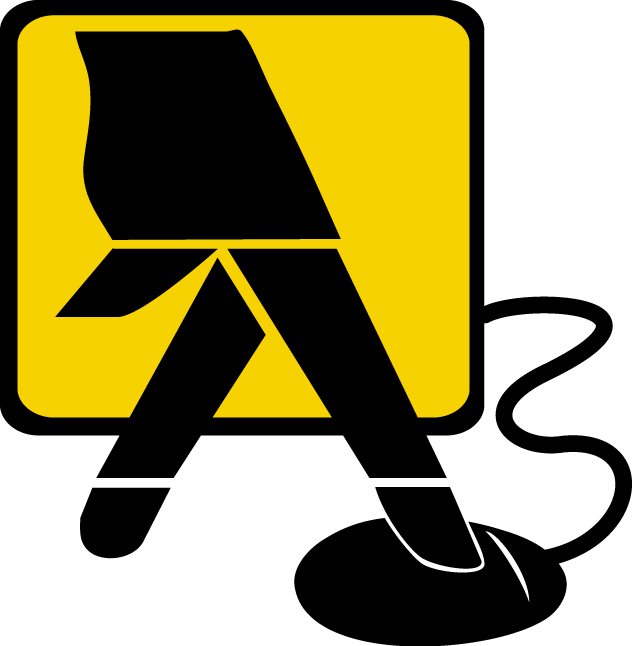 the arts on a community’s economy. Knowing this, how do we make intelligent use of the services creative individuals and organizations offer and ensure they are not wasted? How can we best connect an artist with an opportunity, the arts with our community? How do we maximize the abundance of creative talent available?
Step one of one: free and easy-to-use online directories, cultural marketplaces, creative economy databases, and yup, you guessed it, social media. Utilizing online directories, artists can expand their networks virtually to an audience within and beyond the physical boundaries of their local community. Community members and those searching for creative talent can be easily connected to a musician, visual artist, performer or arts organization. Below is a sampling of online directories and registries developed to promote the arts, build networks, and create meaningful connections between artists and arts patrons.
the arts on a community’s economy. Knowing this, how do we make intelligent use of the services creative individuals and organizations offer and ensure they are not wasted? How can we best connect an artist with an opportunity, the arts with our community? How do we maximize the abundance of creative talent available?
Step one of one: free and easy-to-use online directories, cultural marketplaces, creative economy databases, and yup, you guessed it, social media. Utilizing online directories, artists can expand their networks virtually to an audience within and beyond the physical boundaries of their local community. Community members and those searching for creative talent can be easily connected to a musician, visual artist, performer or arts organization. Below is a sampling of online directories and registries developed to promote the arts, build networks, and create meaningful connections between artists and arts patrons.
- Pittsburgh Artist Registry: Free to join and use, the Pittsburgh Artist Registry features multidisciplinary, Pittsburgh artists and organizations. Though the registry includes only artists and organizations native to Pittsburgh, its reach is far greater, exposing artists to curators, businesses, developers and organizations worldwide.
- Matchbook.org: New England’s cultural marketplace with the end goal to ‘MATCH artists with the presenters that BOOK them.’ Get it?! A platform for a creative exchange of sorts, Matchbook.org has a user-friendly interface and a growing directory cataloging New England’s performing and visual artists, organizations, and creative venues. Those doing the booking can restrict their search using such criteria as art discipline, price range, and audience type.
- 2 Degrees Portland: Moving to Portland, Maine? Relocating a creative business? Are you an artist, inventor, performer, designer? Need help securing a place? Want more information about school districts, studio availability, or local arts grants? 2 Degrees Portland, an initiative of Creative Portland, was designed to connect creators that are soon-to-be-Portland-residents with the people they need and want to know. 2 Degrees Portland utilizes Facebook and online surveying to connect and welcome new creative residents to the city. Without a doubt, a better “Welcome to the Neighborhood” gesture than a fruitcake.
- Brooklyn Arts Council Registry of Brooklyn Artists: This expansive registry organizes Brooklyn artists across disciplines, providing both artists and consumers of the arts access to unique opportunities. For artists, registering for a listing includes membership to the online discussion community and access to the bi-weekly newsletter. For community members, educators, curators, collectors, city officials, and the general public, we can search, discover, book, hire, and love that Brooklyn talent. Additionally, users can search the Brooklyn Arts Council Directory of Organizations for a listing of Brooklyn based arts organizations (galleries, presenting institutions, performing arts schools, historical societies, etc.).
- ArtsConnection Engine: A free service of IndianaArts.org, ArtsConnection Engine (ACE) is Indiana’s cultural portal connecting artists, businesses, arts organization, and arts patrons. The site allows a user to search by artist, organization, classified listing, or event. Each category is then divided by sub-categories, for a more refined and exact search.
- Americans for the Arts, Arts Services Directory: A national directory for use by both artists and patrons of the arts. Unlike local directories that match artists with those looking to be connected with their talent or service, Americans for the Arts provides a comprehensive listing of companies, organizations and resources to advance a community’s cultural and creative economy. The directory offers a range of search options, such as Program Area (i.e. cultural tourism or grantmaking) and Organization Type (Consulting or Regional Arts Agency) to facilitate your search.
From Portland, Maine to Pittsburgh, Pennsylvania and beyond, cities and towns are brimming with creative individuals and organizations that enrich our day-to-day lives, strengthen our economies, and revitalize our communities. Resources such as online directories and creative marketplaces provide a platform for artists and communities to connect- a mutually advantageous opportunity.
Plus, searching an online directory is nowhere near as cumbersome as flipping through the yellow pages, a la Grandma. And that’s the beauty of the intersection of technology and the arts.
How do you identify and connect with the artists in your community? How might technology better serve this connection?
Can the arts successfully have a game dynamic?
 A game dynamic simply put is an element of a game: levels of achievement or rewards, economic systems to exchanging rewards or credits, cooperative and/or competitive aspects, design layers that change dynamics from one episode to another, and even a series of collectibles can be represented as game dynamic. Game dynamics have recently contributed towards solving medical mysteries, namely the gene folding break-through made on the fold.it puzzle game online.
A game dynamic simply put is an element of a game: levels of achievement or rewards, economic systems to exchanging rewards or credits, cooperative and/or competitive aspects, design layers that change dynamics from one episode to another, and even a series of collectibles can be represented as game dynamic. Game dynamics have recently contributed towards solving medical mysteries, namely the gene folding break-through made on the fold.it puzzle game online.
Now this remarkable game is being put to use to solve the gene folding challenges of Parkinson’s disease among others. Additionally, there have been arguments that game dynamics are what make sports sectors of the economy flourish. Sports use a game dynamic that creates cooperation through competition. It is easy to see the potential between game dynamics and the arts but adoption of this idea has yet to garner a widespread support. Check out the previous blog: Planning for Engagement for how cell phone voting is being used at the Indianapolis Symphony Orchestra. As another example, The AWARD show at the Joyce SoHo presents a level of competition driven by reward - in this case cash prizes for the winners of voting contests.Some artists have ventured, guns blazing, into game dynamics; the show Best Before by Rimini Protokoll, for instance: “Pulls the multi-player video game out of the virtual realm and rewires it for an intimate theatre setting.”
The answer to the original question posed “Can the arts have a game dynamic successfully?” is yes. Few creative artists or institutions choose to engage audiences through game dynamics whole-heartedly. Through utilizing game dynamics, the arts world can overcome certain aesthetic hurdles and adopt game dynamics for its potential for growth. The result could have an immense impact.
The tools to create these dynamics in the performing and visual arts are available at both high and low technologies, and can be relatively inexpensive. Cell phone voting systems can be purchased from vendors for under $100. At a small scale, usage of http://www.scvngr.com/ allows for a geographic based scavenger hunt and is relatively cost effective. Immediate interaction with audiences can be had by using audience response systems, which are shown to increase attentiveness in schools.
There are rewards at certain institutions for arts patrons who commit to a level of involvement. There is the relatively common backstage pass, open rehearsal, or meet the artist offerings for subscribers or high-level donors, but these rewards carry with them seemingly little appeal to younger audiences in general. (Of course this is with exceptions.) In the philanthropic world, voting contests abound to great success. In the coming months I will be using this blog to explore technological tools for implementing game layers in a variety of different ways. I look forward to the conversations that I hope to have with everyone on this topic!
The Future of Net Neutrality and What it Means for the Arts Community
 Of all the public policy issues relating to the intersection of arts and technology, arguably none is more important and vital to our continued freedom and success than net neutrality. A slew of recent changes and lawsuits have the potential to fundamentally change the way we use the internet, and the arts community stands to be greatly impacted.
The idea behind net neutrality is simple: keeping the internet open and treating all data equally. The word “neutrality” means strictly that: whether you are searching for information on Google, streaming video on Netflix or using social networking tools, all of those data “packets” are treated equally and allowed to proceed at the same speed. This is the very idea of the “open internet” that so many in the arts community advocate and support, and it has helped foster innovation and evolution in many different fields, including the arts.
Of all the public policy issues relating to the intersection of arts and technology, arguably none is more important and vital to our continued freedom and success than net neutrality. A slew of recent changes and lawsuits have the potential to fundamentally change the way we use the internet, and the arts community stands to be greatly impacted.
The idea behind net neutrality is simple: keeping the internet open and treating all data equally. The word “neutrality” means strictly that: whether you are searching for information on Google, streaming video on Netflix or using social networking tools, all of those data “packets” are treated equally and allowed to proceed at the same speed. This is the very idea of the “open internet” that so many in the arts community advocate and support, and it has helped foster innovation and evolution in many different fields, including the arts.
Many of the projects we have highlighted here on the blog in the past week, including art.sy, the Google Art Project and the Tate Trumps iPhone app, are made possible in part because of the freedom that net neutrality provides. Whether it’s an artist finding new outlets for their creativity, using the internet to connect buyers and sellers, or arts organizations using social media to find new fans, the increasing merger between the arts and technology communities is absolutely dependent on the idea that the internet should be free, open and neutral. Doing away with the concept, or diminishing that freedom, would have a severe negative impact on the arts community.
Thankfully, some recent changes have been put into place to strengthen net neutrality. Recent regulations approved by the Federal Communications Commission (FCC) are set to take effect November 20, 2011. These regulations include prohibiting broadband providers from blocking lawful web traffic, requiring a greater deal of transparency from broadband providers regarding their network practices, and, most importantly, requiring that broadband providers not discriminate in transmitting lawful network traffic over consumers’ internet service. You can read more about the new regulations on the FCC’s openinternet.gov website.
While the regulations are not perfect, and do not go as far as many open internet advocates would have liked (for example, there is still some ambiguity regarding the regulations surrounding wireless networks, which the FCC claims is a newer technology and requires more time to appropriately measure how much regulation is required), they are a welcome step in the right direction.
Before we get to November 20 however, several lawsuits have been filed in the past few months, seeking to block these regulations. And to no one’s surprise, it has been the telecommunications companies that have sought to block the regulations from being put into place, while at the same time claiming that they are the true parties interested in keeping the internet “open.”
The most recent lawsuit comes from Verizon, one of the largest telecommunications companies in the country, who are claiming that while they are committed to an open and secure internet, they object to what they call “sweeping” regulations that apply to the entire telecommunications industry. This is not the first time Verizon has filed suit against the new regulations; they also sought to remove the new regulations earlier this year, but the case was thrown out in April because the regulations were not published in the Federal Register until this past August.
The lawsuit is pending, and whatever decision is reached by the courts will have a lasting impact on the future of internet freedom. Even if the FCC and open internet advocates prevail, the fight by the telecom companies against the new regulations will surely continue, as they seek to continue their years-long crusade against the open internet and restrict whatever types of internet data they see fit.
We here at Technology for the Arts have long advocated for net neutrality and communicated why we feel the issue is of vital importance, and as the fight over the open internet heats up, it’s important that when we talk about issues of arts advocacy and what issues are at the top of our agenda, that we include net neutrality. While the recent regulations approved by the FCC are a welcome step forward, there is a still a lot of work to be done to make sure that the future of the internet remains open and neutral. You can find out more about net neutrality at openinternet.gov, and we encourage you to share the information with others in the arts community.
The arts community has long benefitted from net neutrality, and the continued innovation we have seen in recent years is dependent on it staying that way.
(Photo: CC by markrabo)
Playing with Art: Tate Trumps iPhone App
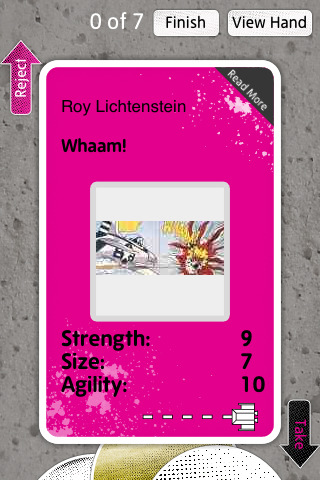 It’s no secret that there are apps for everything and art museums are no exception. The Mattress Factory lets you ask is this art and subsequently allows you to answer that question. The Andy Warhol Museum lets you put yourself into a painting with their D.I.Y. POP app. The Tate Modern has Tate Trumps to let you battle your friends with works of art.
Yes, that’s right. Released in June of 2010, Tate Trumps is an application designed to increase viewer interaction with the works within the Tate Modern with a “bloody fight to the death”. Unlike the aforementioned apps, which allow users to interact with art anywhere, Tate Trumps only works within the confines of the Tate Modern.
It’s no secret that there are apps for everything and art museums are no exception. The Mattress Factory lets you ask is this art and subsequently allows you to answer that question. The Andy Warhol Museum lets you put yourself into a painting with their D.I.Y. POP app. The Tate Modern has Tate Trumps to let you battle your friends with works of art.
Yes, that’s right. Released in June of 2010, Tate Trumps is an application designed to increase viewer interaction with the works within the Tate Modern with a “bloody fight to the death”. Unlike the aforementioned apps, which allow users to interact with art anywhere, Tate Trumps only works within the confines of the Tate Modern.
Described as a “digital card game”, Tate Trumps is a free iPhone app for up to three players, which encourages users to travel the museum and collect points by looking at works of art. Players collect seven works of art and no work of art can be collected twice. A game of Tate Trumps has a minimum time requirement of a half hour, though there is no maximum time limit. Users meet up at the end of their adventure and play a game of trumps against each other, using the works of art they’ve accumulated.
Tate Trumps includes three modes. Battle Mode has users judge how useful a work of art would be in a fight, if it were to come to life. Players search for works of art that are exhilarating, menacing, or absurd in Mood Mode. The final mode, Collector, is for players that “wish they had a gallery of their own”, as they search for pieces that are famous, recently produced, or practical to house.
The viral video for Tate Trumps promises that “galleries will never be the same again”, which incites the question, do galleries need to change? Tate Trumps is a fun, light-hearted way to look at art with the intention of increasing viewer interactivity with the pieces. Does it accomplish this, or is this application trivializing the experience of the museum?
There aren’t any easy answers, and there may not be a right answer. I feel that Tate Trumps has strong potential to accomplish its goal of connecting the viewer with the works. The time limit and inability to repeat pieces in a game means that in a full game, players will spend at least a half hour looking at a minimum of twenty-one works of art. The different modes force the player into critically analyzing the works of art, on multiple levels. The idea of this application may not be appropriate for every museum setting, but could it work for you? Would you play an app game in an art museum?
Leveraging the Virtual and the Real
The art world is experiencing a virtual boom. A boom that began with the advent of the street view technology used by Google, which has now forayed into the world of art. Within the last two years, the Google Art Project has photographed, digitized, scaled, and organized some of the most famous artworks in renowned galleries and museums such as the Tate, the Uffizi Gallery, and the Palace of Versailles. Moreover, this digitization of famous artworks is not any mere reproduction; rather it is a reproduction of the grandest or perhaps the smallest of scales: gigapixel images.
Photograph by Amantini Stefano/4Corners Images
This technology has revolutionized the way we interact with art even though it can in no way be deemed an equal alternative to the real experience. The digitization of museums and galleries has captured their tangible and physical aspects, but not their essence. A visit to the Palace of Versailles will never compare to visiting a website. So the question begs to be asked whether this virtual experience guides, develops, and enhances our real experience. Does the virtual help the real? And what can arts organizations gain from this insight?
Detail from Sandro Botticelli’s Birth of Venus (from the Uffizi Gallery, Florence)
A visitor recently set off an alarm, a really loud alarm, in a museum in Basel when she got too close to an artwork. This encounter illustrates how a public viewing experience within the confines of a gallery or a museum can act as a barrier. More often than not, we are afraid to get too close to painting, even though we want to (with the exception of the aforementioned visitor, of course). We also feel the need to constantly move from one painting to the next until we reach a point of complete and utter visual saturation, perhaps even visual exhaustion.
In the virtual confines of the Google Art Project, we can get eerily yet brilliantly close to our favorite artworks on our very own laptops. We can see details that could not have been physically possible under any circumstances in a museum setting. We can also pause for as long we please and we can leave and return as we please. On a whole, a virtual art world as powerful as that of the Google Art Project enriches and builds upon our real experiences.
Detail from Louise Elisabeth Vigée-Lebrun’s Marie-Antoinette de Lorraine-Habsbourg, Queen of France, and her children (from the Palace of Versailles)
Yet, however exquisite and detailed the world of the Google Art Project may be, unlike the masterpieces it virtually showcases, it cannot boast of having attained perfection. An article in the Daily Beast highlights the fact that while the Google Art Project has enabled us to view artworks in a manner that is unprecedented, it is not clear whether we are seeing better.
In the same vein of thought, the author of a blog post in Freize argues that by bringing us closer to works of a bygone era, such as Caspar David Friedrich’s The Monk by the Sea, the Google Art Project has ignored the dynamism of the art world, where the concept of a masterpiece and the artist genius are constantly evolving. The post also mentions how Google is guilty of not explaining to us why certain artworks were, and still continue to be, worthy of the title of a masterpiece.
The Monk by the Sea, Caspar David Friedrich (from the Alte Nationalgalerie, Berlin)
For arts organizations looking to create a virtual experience, let’s analyze the advantages and the disadvantages. A virtual experience can create a longing and desire for a real, physical experience. The aforementioned article in the Daily Beast provides an interesting insight from the Director of MoMA about virtual outreach: the virtual presence and proliferation of art works housed at the MoMA actually compelled the true lovers of art to seek out the real. Consequently, the MoMA has had a twofold increase in attendance over the last ten years.
Another big advantage is increased accessibility to audiences around the world. But accessibility alone is not adequate and arts organizations should be wary of becoming just another collection of images on the World Wide Web. The aim is to educate people and generate interest, not pander to their aesthetic appetites. A virtual experience that is no different from a collection of images limits the potential of technology as a vehicle for education, discussion, thought, and reflection. Thus, arts organizations should look further than the potential of the online world as a visual cache because only then will they truly be able to leverage the virtual and the real.
Steve Jobs: The Epitome of the Arts and Technology Intersection
From Six Degrees of Separation to Art.sy
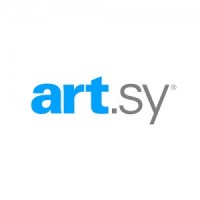 Whether your goal is to start an art collection, expand your collection, discover a new artist, or simply to keep up with everything there is to know about your friends on Facebook, the soon-to-go-live startup website Art.sy is worth a look.
So you want to be an art collector? You have been thinking about purchasing your first piece of artwork (and I do not mean the Starry Night print you purchased from poster.com…), but you do not know where, when, why, how much, what, or how to proceed. Maybe you are a veteran collector, for profit or not, and are looking to expand your collection. Let Art.sy do the work for you.
Whether your goal is to start an art collection, expand your collection, discover a new artist, or simply to keep up with everything there is to know about your friends on Facebook, the soon-to-go-live startup website Art.sy is worth a look.
So you want to be an art collector? You have been thinking about purchasing your first piece of artwork (and I do not mean the Starry Night print you purchased from poster.com…), but you do not know where, when, why, how much, what, or how to proceed. Maybe you are a veteran collector, for profit or not, and are looking to expand your collection. Let Art.sy do the work for you.
Created by Carter Cleveland, a Princeton University computer science engineer, and backed by a handful of today’s most influential players in the social media, fine arts, and technology industries, Art.sy is the newest and potentially most powerful addition to a collector’s and artist’s networking toolkit. Don’t believe me? Maybe you’ll believe some of its investors and advisers including the CEO of Google, Eric Schmidt, Twitter creator, Jack Dorsey, the owner of Gagosian Gallaries, Larry Gagosian, former executive at Christie’s Auction House, Sebastian Cwilich, and the CEO of Pandora, Joe Kennedy, just to name a few. If you are a new, online startup, it is safe to say THOSE are the names you want associated with your project. So now that we have established just how popular Art.sy is among the big wigs in the industry, let’s figure out why.
If you have ever used Pandora to search for a song or musician, you are already familiar with “genome technology” and how Art.sy will perform. What differentiates Art.sy from the rest is the Art Genome Project. A simple search for a painting will return not just the desired title, but additional works of art related to the original search recommended for you by yours truly, Art.sy. Each work in the collection is classified by various characteristics such as asking price, genre, theme, colors, period and “ism” to connect it with other paintings in the database. A search for one painting will generate a list of paintings that share similar classifications, exposing users to artists and paintings they may not have been familiar with. Linking with Facebook and Twitter, Art.sy users can share their searches and discoveries with others, educating a wider audience and strengthening the presence of art online.
For example, a search for Max Ernst’s surrealist painting The Couple in Lace would return not only the painting itself, but information on Ernst, the painting, its location, paintings of other Dadaists and Surrealists, paintings of couples by other artists, and paintings whose creators were influenced by the work and style of Ernst. Note well, Art.sy is geared more toward lesser-known and on-the-rise artists (sorry, Ernst) because its users are likely to be beginner collectors with smaller price ranges.
For each work of art, Art.sy will provide the specifics for contacting the gallery or the artist (where possible) to begin a conversation and facilitate a purchase. Making collectors of those who previously could not or did not know where to begin is just the beginning of what Art.sy has to offer us.
Since its initial launch last November, hype has only grown. The collection itself is still in development and has yet to go live, but you can visit its website to register for your official invitation to join what could be the most extravagantly marketed and led, online network making fine art accessible to the masses. Will you RVSP?






